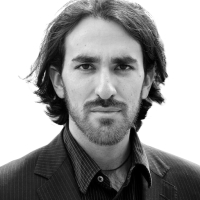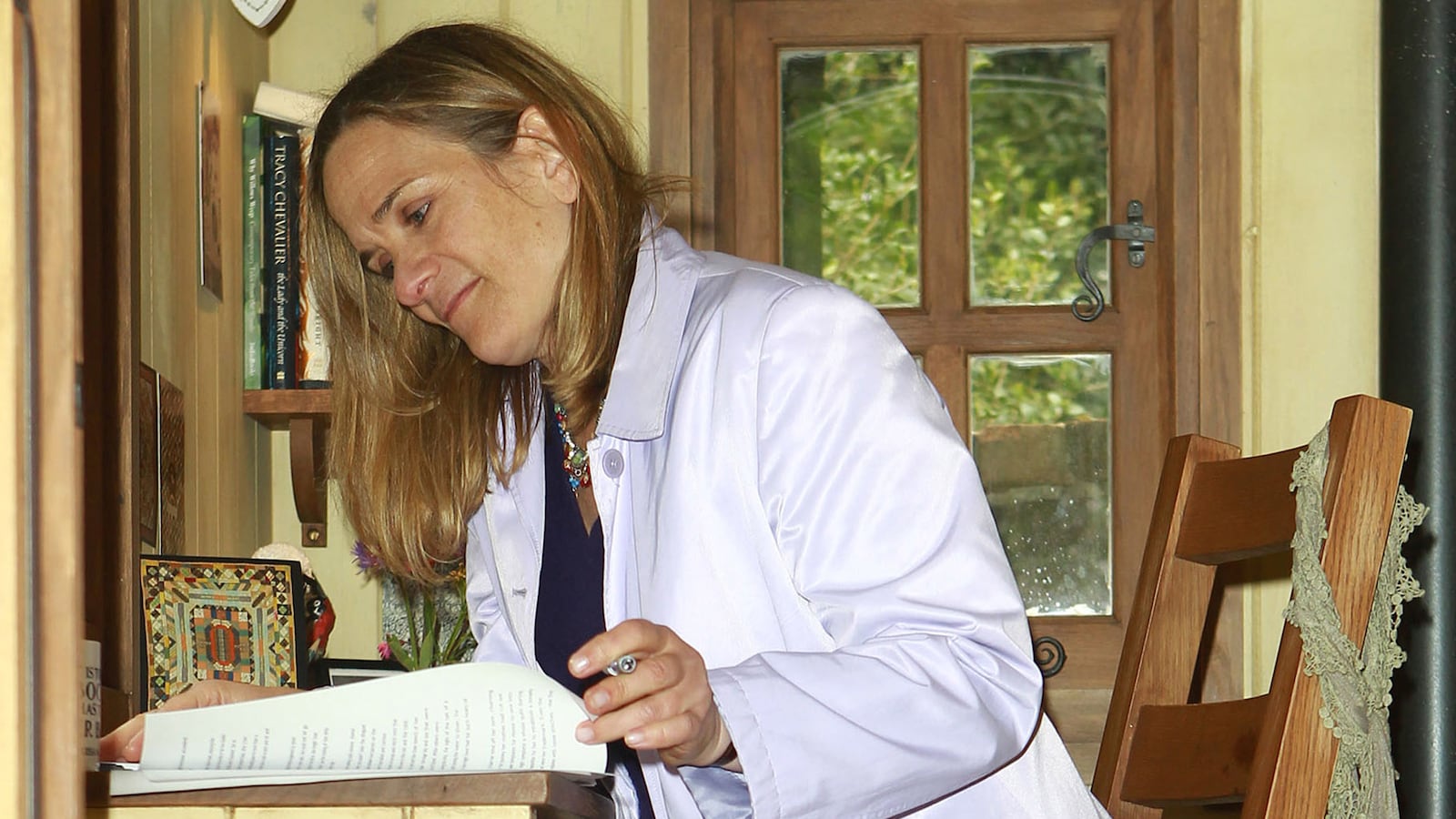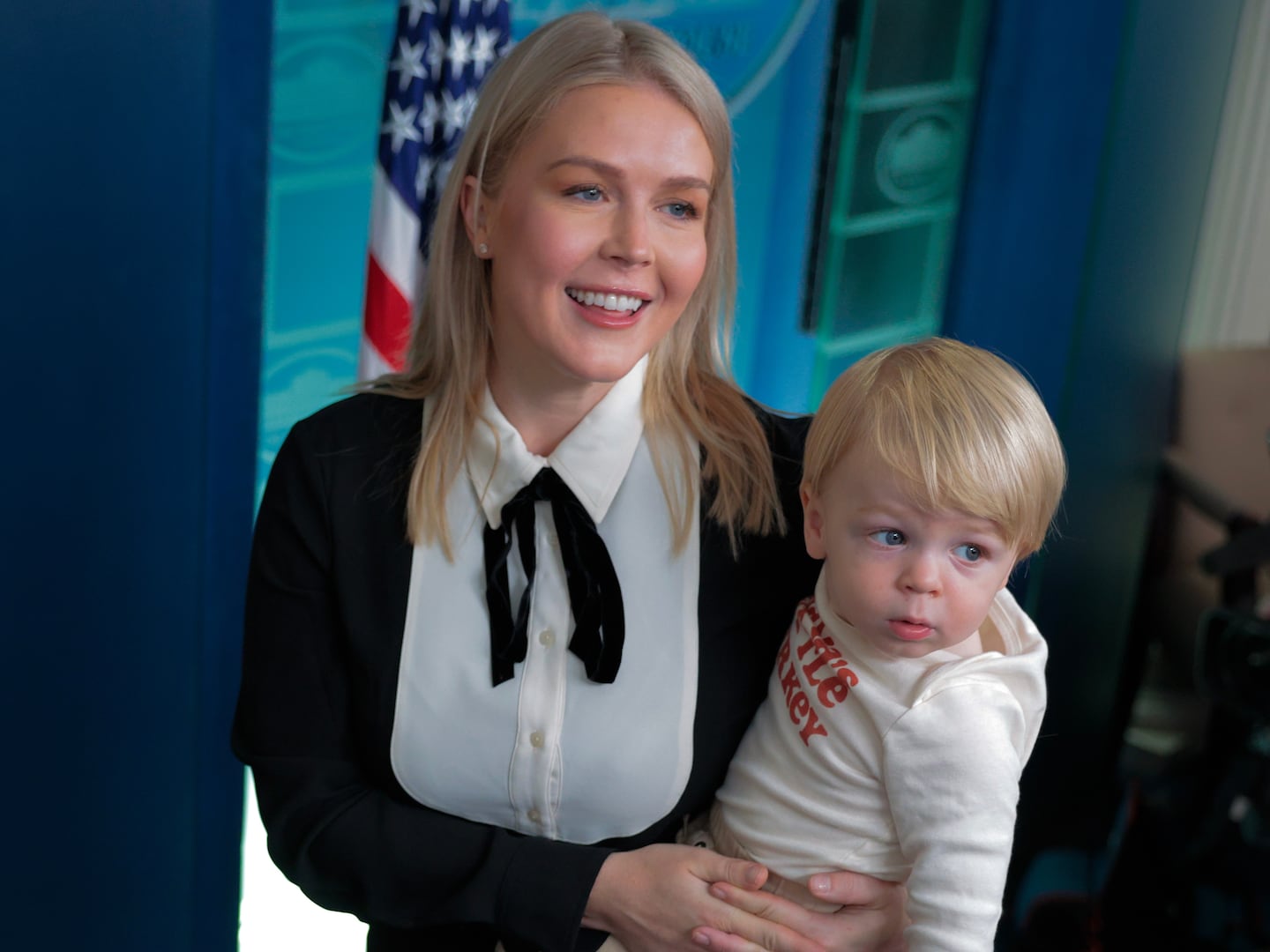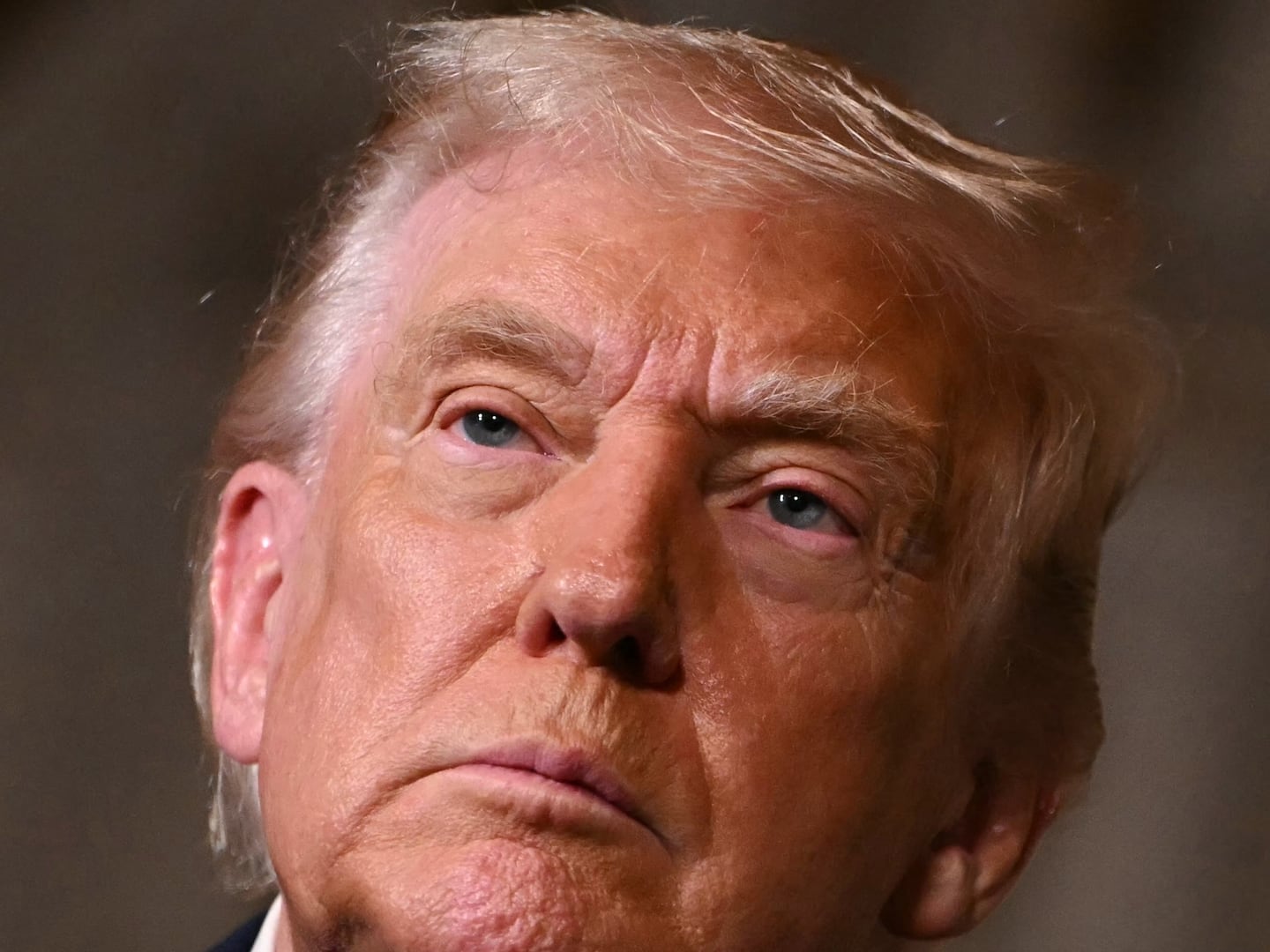Describe your morning routine.
Okay. This is assuming I’m having a productive writing day! A lot of the time that doesn’t happen. A good day? I get up, I wake my teenage son up, we have breakfast, and he leaves at 8. That’s the cue for me to go to my office. My writing life has shifted slightly over the years, but what works best for me now is if I start writing immediately. I’ll check my email to make sure there’s nothing I need to deal with right away, then I read what I’ve written the day before. That jolts me into continuing. Ideally, the day before I’ve left a little bit left in the tank, so to speak. Not like Graham Greene—he used to write 500 words a day, and if the 500th word was in the middle of a sentence, he’d stop. I’m not that bad, but what’s really useful is to have a little left that you haven’t quite gotten down on paper. Then I can use that in the morning to get started. A lot of times, if the writing goes well, I’ll be done by 10. Sometimes I’m still working at 6. It depends on what I come up against.

Do you have a goal in terms of word count each day?
I try to write 1000 words on a good day, about three pages. The reason for that amount, it feels right to me because most of the scenes I write are 3000-4000 words long. Not always, but on average. That means that I get 3-4 days per scene, which is good, because sometimes I’ll read it and feel—I feel different on different days, so it means I won’t have just one tone per scene. I have several different cracks at it.
I’ll often be in the middle of writing and realize I don’t know what I’m writing about. For instance, today I’ve been writing a scene about a man who’s grafting apple trees. So I have to stop and look at my notes about grafting. Just now I was thinking, I still don’t really understand this. I need to order a book at the British Library and go and read it tomorrow. That’s what happens as I go. So what I’ll do is write a basic part of the scene, but for the grafting bit…I’ll put down three stars. Three stars in a manuscript for me means there’s something missing, I have to go back and fill it out. I don’t want it to stop my writing flow, but I’ll leave it aside and do the rest of the scene without it, come back and fill it in later. That’s a good interruption. A bad interruption is when I can’t focus and I wind up fiddling around online, having lunch with a friend, or something like that. What I’m aiming for is that concentrated time of focusing.
I’ve now done over 70 of these interviews, and you’re the first author who talks of writing in terms of “scenes.” This term makes perfect sense, but I guess the way that most authors deconstruct their book either uses a different term or approaches the text with a different unit. Maybe you could describe your routine when conceiving of a book and its plot, before the writing begins?
I love what I call a “scene,” which is when there’s actually something happening between two or more characters. But a lot of times, the work isn’t that—it’s the glue between the scenes. Flashbacks, filling in, description. My favorite bit is the scene with action and dialogue. I love dialogue, I know a lot of authors hate it. If I could write a whole book just in dialogue, I’d be very happy. So that’s what I meant by a scene.
Planning is such a tricky issue. I just heard Khaled Hosseini say that he never plans anything out. He just feels like the story is out there and he just has to start writing and it comes to him. I sort of know what he means, but I don’t think I could be that bold. I have an idea, before I start writing, of the arc of the whole book. A book is a journey, usually the main character’s. And the arc of this journey is how the character’s going to change. When I write, it’s a matter of working out how they get to that end point. Sometimes I know the big moments throughout the book, but I rarely know ahead of time the small moments. It’s a combination of knowing where I’m going and the spontaneity of allowing the smaller moments pop out that lead to the big moments.

I once saw a manuscript exhibition at the New York Public Library, and I saw Paul Auster’s outline for the first chapter of his New York Trilogy. It was incredible, because it was really long and detailed. Pretty much as long as the final ended up being, but it was just the outline. I thought, that would never work for me. If I did that, it would kill my prose. A story works best when it’s just emerging, like the writer’s writing it just one sentence ahead of your reading it.
Your points of departure for a number of books have been a work of art. Do you know, upon seeing a work, that it could speak to you? What lead you to the works of art, like Vermeer’s Girl with a Pearl Earring?
I don’t deliberately look at art for the story. I mean, I do that for fun in a gallery. For Girl with a Pearl Earring and the Lady and the Unicorn tapestries, and the works of William Blake, there was a specific moment when I felt that each was a book I wanted to write. Girl with a Pearl Earring, I was lying in bed where I had a poster of the painting in my room, and I thought, I wonder what Vermeer did to make her look like that at him? Lady and the Unicorn tapestries? I’d seen them, but I read an article about them, and I just thought, Wow, this is exactly what I want to write about. Blake? I was at an exhibit of his work at the Tate in 2000. I had read his poetry, I’d seen some of his illustrations, but I’d never seen them together. I walked around the exhibition, and it was the cumulative effect of this man’s unusual mind on me. Towards the end of the exhibit, I thought, This guy was nuts! I’ve got to write about him. He’s still nuts! So these were very particular moments. It’s like, if you’re tapping on a wall, and it’s solid, solid, solid…then suddenly you tap and you hear hollow. You think, Ah, that’s where the treasure is hidden! It’s that sudden change. Most artworks I look at and I don’t feel that. What is it about these things that makes it feel like I want to write a novel? It isn’t always art. My last book but one, Remarkable Creatures, was about a fossil hunter, Mary Anning. I had the idea to write about her when I was at a small dinosaur museum in Dorset. There was a little exhibit about her and I thought, I’ve got to write about her. It’s like an opening. They all have in common a gap, a void of information, something we don’t understand or is unresolved. For Girl with a Pearl Earring, I just wanted to know why she was looking like that: this combination of happy and sad, innocent and experienced. It’s an unresolved painting, which is what makes it so very powerful. You can go back to it again and again and never be satisfied, that you never know the answer to it. Have you ever been to the Musee Cluny to see the Lady with the Unicorn tapestries?
I have.
Then you know, it’s hard to leave that room. There’s something astonishing about them. I ended up staying there for an hour and a half staring at them. I’ve watched other people walk into the room and not be able to leave, because they’re not satisfied that they’ve seen all there is to see. It’s so overwhelming. There’s something that holds you, that you’re trying to answer, but can’t. I liken it to the penultimate chord of a song. You’re stuck on it. That’s powerful art. You look, you want an answer, and you don’t get it. I try to come as close as I can to the answer, by writing books about them.
I’m curious what your experience was like watching a film of your book? A lot of writers who haven’t had a film made of one of our books fantasize about it, but I imagine the feelings must be mixed when you watch the finished product?
It is a mixed experience. There’s something slightly threatening about seeing a film. When I write and when I read, I make a film in my head. Most of us do that. We imagine the characters ourselves, and we have a film turning in our heads. The threat of a real film is that it’s going to usurp, dethrone your personal film. I was worried about that when I went to Girl with a Pearl Earring. Would I always imagine Griet as Scarlett Johansson? Even worse, are my readers going to do that? I write the books for them, not for me. Luckily, I was happy with the film. I was relieved, that’s probably the best word. It was true to the tone of the book, and I really enjoyed watching Scarlett do her thing. She receded after a few weeks, but my Griet was still with me. I hope that’s the case with readers. I think it usually is when you read the book before you see the film. The first imprint is of your own imagining. If you see the film first and then you read the book, the film does a lot of the work for you. You see Scarlett first, so that’s how you imagine Griet. I think that way round, the experience isn’t as powerful. I was fascinated with what the film-makers come up with, and it’s fantastic to know that you’re bringing a story to a much wider audience than with a book alone, but I balance that out with knowing that the reading experience is more powerful than the film experience. I say that, but then some of the most powerful experiences I’ve had recently have been on-screen. I just finished watching Breaking Bad…
Oh my god, I did too. My wife and I just finished it last night.
Oh, you’re kidding! [Laughs] What did you think of the final episode?
I found it satisfying. I didn’t realize how it was going to end, but it was bleak leading up to it, killing off so many people that I liked.
Oh, I know. I found it satisfying too, but I was dissatisfied that I was satisfied. It was such a surprising story. So many times you think you understand it, and then there’s a surprising twist. We want to be satisfied, but also surprised. Other times they’ve managed to do that, but since this was the final episode, they had to tie things up. There was a sense of “Oh, is that all?” But I liked what they did with Elliott and Gretchen, the lasers with Badger and Skinny Pete. What Walt did with the money was incredibly clever, and I could not have predicted that. I thought it was all set up as the father-son thing, that Jesse has to survive and Walt has to die. And you gotta get the neo-Nazis, to satisfy the audience. I wasn’t surprised how that played out. But it didn’t make me think “Wow, this is amazing story-telling,” which I had thought often in the series. Also I’m just incredibly sad that the whole series is over.
It was also brave of them to end without any character who you could wholly cheer for. That’s brave to have no one to hold onto as your protagonist, the one you’re rooting for. By the end it’s hard to be rooting for Walt…
I still rooted for Jesse. I was so relieved that he survived. My son and I were sitting there when he was driving away at the end like a maniac. We were so nervous that he was going to crash! I thought, Please don’t do that to us! That would just kill me!
What is guaranteed to make you laugh?
Oh god, Peep Show. It’s a British sitcom, and it’s hilarious.
What is guaranteed to make you cry?
Killing off my favorite characters.
Do you have any habits or affectations related to your writing process?
I always buy notebooks for research and writing, and I try to buy ones that reflect the theme of the book, the color. Doesn’t Isabel Allende always have to start a book on January 6 and, if she doesn’t, she doesn’t write for the year? I wish I could tell you something like that, because that would really crack me up! I’m afraid for me it’s just notebooks.
Tell us something about yourself that is largely unknown and perhaps surprising.
I have this weird liking for prime numbers.
Any favorite prime number?
23.
What is your favorite snack?
Ha! Chocolate. Green and Blacks almond or butterscotch.
What would you like carved onto your tombstone?
Oh, man. That’s so hard… It makes me think of this New Yorker cartoon: “I’m outta here.” I think I’d just have my name, actually. Words fail me when it comes to death.
This interview has been edited and condensed.






